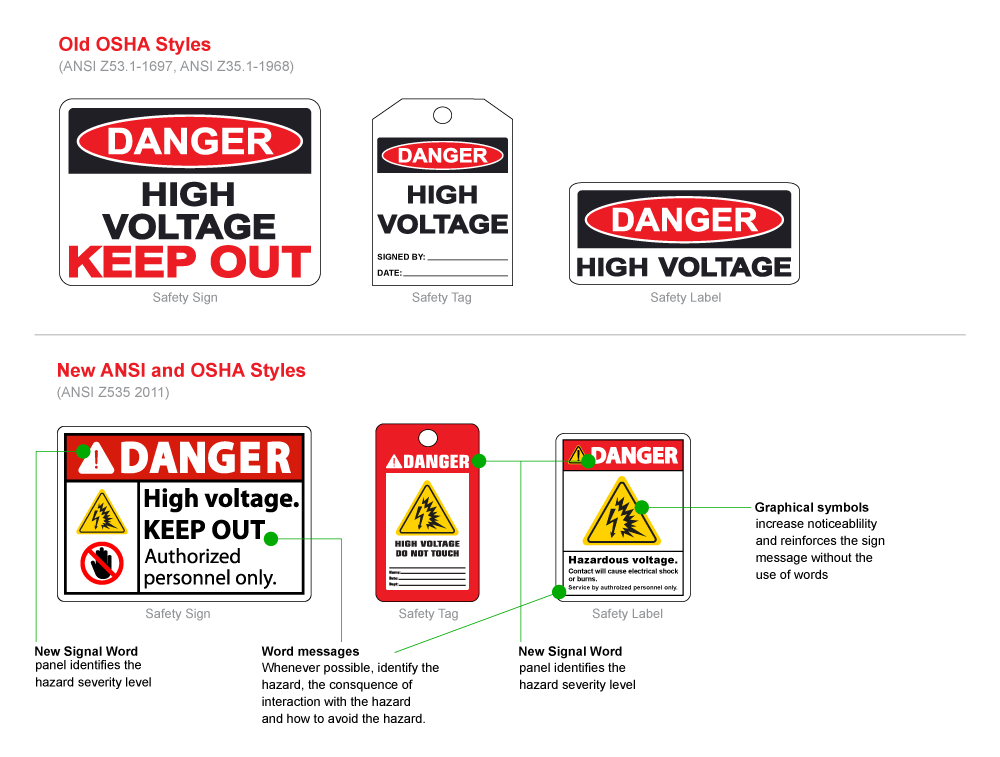OSHA Sign Format
How can safety signs be formatted according to OSHA guidelines?
OSHA, which stands for the Occupational Safety and Health Administration, has established precise guidelines regarding the format of safety signs. These guidelines are in place to ensure consistent and effective communication of hazards and safety information in the workplace. By adhering to the OSHA format for safety signs, organizations can promote a safer work environment and reduce the risk of accidents or injuries. Compliance with OSHA standards is crucial for employers as it helps them fulfill their legal obligations to provide a hazard-free workplace. Furthermore, following the OSHA format ensures that safety signs are standardized, easily recognizable, and understood by employees, thereby enhancing overall safety awareness and promoting a culture of workplace safety.

What are the reasons for adhering to the OSHA safety format?
Adhering to the OSHA safety format for safety signs is essential for several reasons. Firstly, it helps ensure the consistent and effective communication of hazards and safety information in the workplace. By following the prescribed format, employers can convey critical messages clearly and concisely, minimizing the potential for confusion or misinterpretation. Secondly, compliance with the OSHA safety format demonstrates a commitment to employee safety and well-being. It helps employers fulfill their legal obligations by providing a hazard-free work environment and reducing the risk of accidents or injuries. Additionally, adhering to the OSHA format promotes standardization and consistency across different workplaces and industries, making safety signs easily recognizable and understandable for workers regardless of their specific job or location. Overall, by embracing the OSHA safety format, organizations can foster a culture of safety, raise awareness among employees, and contribute to the overall well-being of their workforce.
What is the significance of ANSI standards?
ANSI standards hold great significance in various industries and sectors. The American National Standards Institute (ANSI) develops and promotes voluntary consensus standards that cover a wide range of disciplines, including manufacturing, construction, engineering, technology, and safety. The significance of ANSI standards lies in their ability to establish uniformity, reliability, and safety in products, processes, and systems. These standards serve as a benchmark for quality and performance, ensuring that products meet minimum requirements and are safe for use. They facilitate interoperability and compatibility among different components and systems, enabling seamless integration and efficient operations. ANSI standards also enhance consumer protection by setting guidelines for product safety, labeling, and performance claims. Moreover, adherence to ANSI standards can enhance international trade and competitiveness by providing a basis for harmonization with global standards. In summary, ANSI standards play a crucial role in promoting safety, quality, compatibility, and global trade across various industries, benefiting businesses, consumers, and society as a whole.
How can safety signs be formatted according to ANSI guidelines?
Safety signs can be formatted according to ANSI (American National Standards Institute) guidelines by following specific principles and criteria. Firstly, ANSI recommends using concise and clear wording on safety signs to convey the intended message effectively. The use of signal words like "Danger," "Warning," or "Caution" helps indicate the severity of the hazard. Additionally, ANSI suggests incorporating easily recognizable pictograms or symbols that represent the nature of the hazard, allowing for quick comprehension across language barriers. The size and placement of safety signs are also important aspects. ANSI specifies minimum viewing distances and letter heights based on the intended audience and viewing conditions to ensure optimal visibility. Furthermore, ANSI provides guidance on color selection for safety signs, using contrasting colors to enhance legibility. By following these ANSI guidelines, organizations can create safety signs that are easily understood, highly visible, and comply with industry standards, ultimately contributing to a safer working environment. Visit our ANSI sign guidelines page for more information.
What is the purpose or importance of having OSHA or ANSI signs?
Having OSHA or ANSI signs serves a critical purpose in maintaining workplace safety and fulfilling regulatory requirements. These signs play a vital role in communicating crucial information about hazards, precautions, and safety protocols to employees and visitors. By prominently displaying OSHA signs, which follow the guidelines set by the Occupational Safety and Health Administration, organizations demonstrate their commitment to prioritizing employee well-being and complying with legal obligations. OSHA signs effectively alert individuals to potential dangers, increasing awareness and promoting safe practices. Similarly, ANSI signs, developed by the American National Standards Institute, ensure standardized communication across industries, improving comprehension and reducing the risk of accidents or injuries. The presence of these signs fosters a culture of safety, reminding individuals to remain vigilant and take necessary precautions. Ultimately, OSHA and ANSI signs serve as visual reminders that prioritize the protection of lives, health, and overall well-being in the workplace.